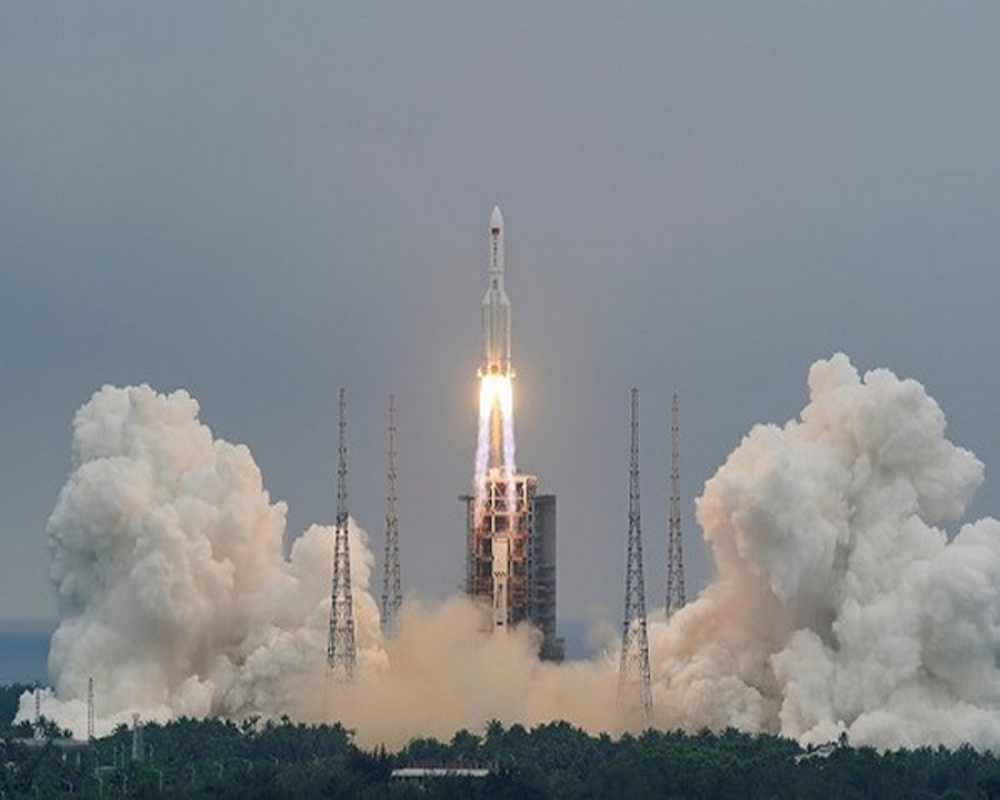The remnants of an out of control and China's biggest rocket re-entered the Earth's atmosphere with most of its parts burned up and disintegrated over the Indian Ocean near the Maldives, the country's space agency said on Sunday, ending days of fevered speculation over where the debris would hit.
The remnants of China's Long March 5B rocket re-entered the Earth's atmosphere at 10.24 am Beijing time and fell into an open sea area at 72.47 degrees east longitude and 2.65 degrees north latitude, China's Manned Space Engineering Office said.
The coordinates put the splash down in the Indian Ocean, close to the Maldives, Hong-Kong based South China Mornig Post reported, adding that most the remnants burned up during the re-entry.
US and European tracking sites had been monitoring the uncontrolled fall of the rocket.
Monitoring service Space-Track, which uses US military data, also confirmed the re-entry.
"Everyone else following the LongMarch5B re-entry can relax. The rocket is down," it said.
"@18SPCS confirms that CZ-5B (LongMarch5B) (48275 / 2021-035B) reentered atmosphere 9 May at 0214Z and fell into the Indian ocean north of the Maldives at lat 22.2, long 50.0. That's all we have on this re-entry; thanks for the wild ride," it said.
The US Space command confirmed the re-entry into the atmosphere of the rocket over the Arabian peninsula, but said it was unknown if the debris had hit land or water.
"The exact location of the impact and the span of debris, both of which are unknown at this time, will not be released by US Space Command," it said in a statement.
Harvard astrophysicist Jonathan McDowell, who tracked the tumbling rocket part, wrote on Twitter, "An ocean reentry was always statistically the most likely. It appears China won its gamble… But it was still reckless.”
The rocket, carrying the core module for China's Tiangong Space Station, blasted off from the Wenchang Spacecraft Launch Site on the southern island province of Hainan on April 29.
The large rocket stage that de-orbited was more than 33 metres (108 feet) tall and weighed more than 20 tonnes, making it the sixth largest object to re-enter the Earth's atmosphere, according to the Aerospace Corporation, a federally funded research organisation based in California.
Very little of the rocket stage's mass survived re-entry, however, with the majority having burned up as it entered the Earth's dense atmosphere at a speed of about 8km (five miles) per second, the Post report said.
NASA Administrator Bill Nelson issued a statement saying: "It is clear that China is failing to meet responsible standards regarding their space debris.”
"Spacefaring nations must minimize the risks to people and property on Earth of re-entries of space objects and maximize transparency regarding those operations. It is critical that China and all spacefaring nations and commercial entities act responsibly and transparently in space to ensure the safety, stability, security, and long-term sustainability of outer space activities,” Nelson said.
Earlier, the Pentagon said on Tuesday that it was tracking a large Chinese rocket that is out of control and set to re-enter earth's atmosphere this weekend.
Chinese Foreign Ministry spokesman Wang Wenbin told the media early this week that a part of the rocket will be burnt and contracted when it enters the atmosphere.
"It is common practice across the world for upper stages of rockets to burn up while re-entering the atmosphere. China is closely following the upper stage's re-entry into the atmosphere," he said.
"To my knowledge, the upper stage of this rocket has been deactivated, which means that most of its parts will burn up upon re-entry, making the likelihood of damage to aviation or ground facilities and activities extremely low," he said.
The rocket launched the first module of China's new Tianhe space station into Earth's orbit on April 29. Its 18-tonne main segment is now in freefall and experts have said it is difficult to say precisely where and when it will re-enter the atmosphere.
At around 100 feet tall and weighing about 22 metric tonnes, the rocket stage is one of the largest objects to ever re-enter the Earth's atmosphere on an uncontrolled trajectory.
Long March 5 rockets have been integral to China's near-term space ambitions – from the delivery of modules and crew of its planned space station to launches of exploratory probes to the moon and even Mars.
Last year, the re-entry of debris from the first Long March 5B flight fell in Ivory Coast, damaging several homes in villages. It was the largest craft to crash to Earth since the US space laboratory, Skylab scattered debris over the southern Australian town of Esperance in 1979.
China is expected to carry out more launches in its space station programme in the coming weeks as it aims to complete the space station project next year.
Once finished, the structure will have a mass of about 100 tonnes, about a quarter of the size of the International Space Station, (ISS), which is 15 years old and expected to be decommissioned in the coming years.
After that, the Tiangong is expected to be the only space station operating in near-earth orbit by the end of the decade.


























